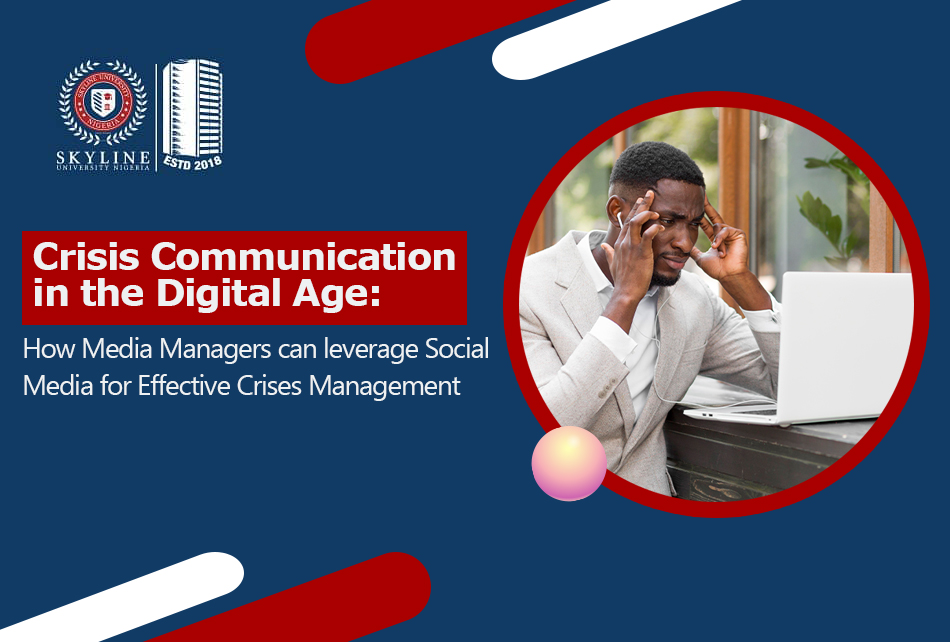Introduction
Like all other forms of communication and information dissemination, crisis communication has also been revolutionized by innovations in the information and communication sphere, which have been spearheaded by advances in technology. These revolutions have tremendously improved the execution of strategies for crisis management, especially in online communities. It has always increased the understanding of vast and diverse audiences through real-time realities.
Crisis Communication and Management
Crisis management, in case of a possible crisis situation, is a process consisting of activities of evaluation of crisis signs, taking and applying necessary precautions in order to recover from the crisis with minimum loss (Simola, 2014).
In the contemporary corporate landscape, marked by unparalleled rapidity of change, corporations encounter challenges in adapting to both subtle and significant environmental shifts. Every day, the extent and breadth of globalization expand, the level of competition rises, and businesses fight to continue operating in the face of numerous crisis threats, (Kara, 2019).
She argues that, since social media’s fundamental building blocks are dynamically generated information, the public is becoming more and more demanding that posts be current, and this expectation is amplified in an emergency or crisis situation.
Civelek, Çemberci and Eralp (2016) collaboratively assert that, any institution could experience a crisis brought on by external or internal causes. Because crises call for quick action and there is a lot of time pressure, being prepared for a crisis in advance is crucial to reducing its negative impacts. Because of this, all institutions and organizations nowadays need to prepare for emergencies.
Therefore, crisis management is an important decision-making process that allows managers or management to address issues and seal reputations with their audiences.
Social Media Channels
Social media has become the most effective communication means in the whole world in a short time because of its sharing networks’ ability and power to keep masses posted, entertained and impressed, (Civelek et al. 2016). According to Odyakmaz (2013), some of the major characteristics include;
- Interactivity: Virtual communication environments such as MSN, Facebook, Twitter, and MySpace are interactive environments. While in traditional media, communication is one-way, and messages are produced by a specific source according to specific rules; in social media, communication is both ways. Individuals are both producers and consumers in all stages of communication.
- Instantaneity: Transferring messages, which can be accomplished by traditional media in an instant manner, is the main feature of the communication through the Internet.
- Serving individuals and masses: Whereas traditional media aims at the masses and is a one-way communication, social media aims at communicating with both the masses and individuals.
- Being beyond space and time: Especially after the improvements in mobile communication technologies, time and place of communication through social media have become unimportant. Everyone, everywhere, whenever they want (as long as they are in the coverage zone), can send and receive messages.
Leveraging Social Media for Effective Crisis Communication
With relative ease, media managers, public relations officers and image makers, among other individuals tasked with the duties of brand management, can utilize social media networks to handle organizational crises efficiently.
Kara (2019) opines that there are four pillars of crisis communication: credibility, authenticity, transparency and responsiveness. Professional brand managers always possess these traits that help them effortlessly relate with audience and regain confidence in times of crisis.
Brand professionals suggest that customers want loyalty and brands need loyalty. It is a prerequisite for finding mutual benefits in the relationship. With the use of social media platforms, both brands and their audiences are able to exchange loyalty efficiently.
With an increasing expectation for regular updates, dynamic engagement and conversational human communications, social platforms urge communications to be more transparent than ever before (Kara 2019). In terms of crisis, communication with the external environment is very important. As a result, the way crisis management is tackled through social media has changed for organizations and businesses. Social media also reduces the stress of using traditional media in order to reach audiences or clients.
Conclusion
Today, the most important communication channel is the Internet. Along with the improvements of Web 2.0 technologies on the Internet, Social media websites have come into prominence since the 2000s. Although social media channels have their shortcomings in terms of fact-checking of contents and their inability to contain viral contents until they die down, they are still better alternatives to connecting with audiences in real time.
References
Civelek, M. E., Çemberci, M. & Eralp, N. E. (2016). The Role of Social Media in Crisis Communication and Crisis Management. International Journal of Research in Business & Social Science 5(3), 2016: 111-120
Kara, A. S. (2019). Crisis communication in the digital age: manage or rampage, Cambridge Scholars Publishing. UK.
Simola, S. (2014). Teaching corporate crisis management through business ethics education. European Journal of Training and Development, 38(5), 483-503.
Nusaiba Ibrahim Na’abba is the Content Writer in Skyline University Nigeria. She has a degree in Mass Communication and a Masters in Communication Studies from Bayero University Kano (BUK).

